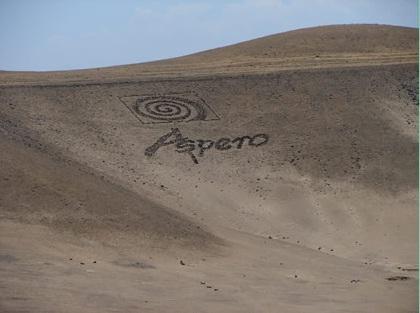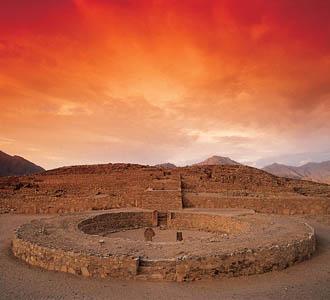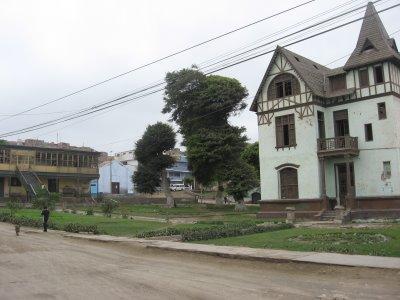Barranca, Lima, Peru
Suggest Place to Visit
1277
Track to location with GPS |
 |
It is in the history of Peru the First Agroindustrial District, due to its factories that produce sugarcane, sugar and paper to date. The settlement of the valley probably begins with the presence of human groups in the period of the Pre-Chavín Regional Formations (2.00 BC), in the elaboration and manufacture of agricultural practice, beginnings in the elaboration and manufacture of ceramics, construction ceremonial center etc. because as we well know, valleys are the propitious places to develop such activities, especially agriculture, which at the same time offers these human groups to become sedentary, and what is more, to use the resources provided by the coast. These and other elements were very important and attractive for men who were looking for better natural and optimal geographical conditions to settle.
Years later in the Formative period (I Horizon) the Chavín culture expanded (1,000 BC), it also established certain influences on that little one; to population. With the passing of the years, the expanding Mochica currents, coming from the north in the years 500d.c., united and amalgamated with greater force and number. The integration of the Mochicas to the social context of primary groups of farmers, fishermen, artisans ... etc, generated the creation of new more complex social and economic formations in their structural, technical and productive organization and also in the ideological and religious field. We can verify this in the historical testimonies found and existing, such as ceramics in their various manifestations, architectural moniments, use of flat land for agriculture, channeling and distribution of water ... etc.
On the basis of the Mochicas and adding to the development achieved, around the year 1300 of our era the great Chimú kingdom developed, which, in its greatest moment of expansion, came to dominate the valleys of the north coast from Tumbes to Paramonga, or according to others, further south, to the Chillón valley in Lima.
According to the chronicle of Father Calancha.
According to Pablo Macera, Paramonga belonged to the third Chimú Region that comprised from the Santa River to the Pativilca River.
During the Chimú dominion (1200 to 1400 AD), in the late intermediate period, Paramonga would be a very strategic area in geographical and military terms, elements that were used by the powerful Costo empire; or. Like the Mochicas, the Chimús managed to configure a much more developed society in the technical, military and cultural aspects, although in terms of social relations of production, the strengthening of a ruling minority that subdued and exploited the mass of peasants and peasants continued. craftsmen.
In the same period of the late intermediate period, parallel to the development of the Chimú, in the southern part of the Andean territory there was another small kingdom, that of the Cusco, made up of various Ayllus who arrived in the region under the command of Ayar Manco or Manco Cápac who was his main curaca. This town extended enormously based on its conuistas, also coming to subdue the Chimús of the north and taking possession of their territories and wealth.
After a short period of domination by the Cuzco people, who thanks to their enormous expansion and power became the so-called Empire of the Incas or Tahuantinsuyo, for a space of less than one hundred years, the European invasion and conquest took place from of the; or 1532, event that will mean the Andean cultural destruction and above all, the implantation of a colonial order, which will last almost three hundred years; os of Spanish domination, until the a; The 1821-1824 in which the Creole independence takes place directed by San Martín and Bolívar to later establish the republican system of aristocratic court. Unfortunately the independence of Peru is promoted by the children of the conquerors but not the conquerors.
ABOUT THE POPULATION OF PARAMONGA IN THE PRE-HISPANIC PERIOD
The Fortaleza valley and the area located between the river that bears the same name and the Pativilca river, was populated since ancient times, pre-Hispanic, that is, before the arrival of the Spanish to what is now called Peru. This affirmation is demonstrated by the archaeological testimonies that show the presence of Mochicas, called Proto-Chimú by Uhle, or Mochic by Tello, and also the Chimú. For this reason, we can and dare to say that Paramonga is an expression of culture with an original and long history, where the men who forged this environment constantly modified the social environment, which was changed and developed at the same time, a product of the contradiction of man with the natural environment, but mainly, a product of his own social contradictions, achieving in this way, forming a population settled in these fertile lands, suitable for cultivation and other activities.
The term Paramonga comes from the Muchic language spoken by the peoples of the north coast, among them the Chimúes who settled in the Fortaleza Valley, its meaning is as follows:
PARÆNG (vassals)
MONGÆAEN (around here)
Translated it would be "Vassals from around here"
Folklore
The Shacshas
It is the most popular traditional dance of the people of Paramonga, whose origins are found in Huarazy, the callejón de huaylas, which, like other folkloric manifestations, was introduced as an integral element of the Paramonguina culture. This is a dance that, like all Andean ones, contains a great magical-religious message in its content, since its practice is strictly related to the patron saint festivities. In their choreography they show us a variety of gestures and ritual movements; which we can appreciate in the processions of religious images, in the churches and in the streets of the town. The dancer tries to represent attitudes of fierceness and mischief or gamonal, carrying a threatening whip and showing a mask that expresses a white and mestizo face. Under the direction of a chief, who is called "EL CAMPERO", who is the most skilled, the other dancers imitate him.
This dance has its greatest representative the Paramonguino JULIO ROSADO, the best countryman of this dance both in the city of HUARAZ and in PARAMONGA.
Another thing that PARAMONGA added to this dance was the feathers that can be seen today both in HUARAZ and in all the places where this dance is danced.
The eminently religious population venerates every September 24 its Patron, ´´Nuestra Señora de las Mercedes´´, also colloquially called Mama Meche or Mechita.
Its main tourist attraction is the so-called Fortaleza, which is rather a temple of Chimu and Mochica origin.
Comments
We don´t have yet any comments about:
Paramonga City
Paramonga City
Be the first to leave a comment as it is very important to inform other people
Outros locais a visitar
Within a radius of 20 km from:Paramonga City
Festung Paramonga |
| 1,7 Km |
 |
Archäologische Stätte von Aspero |
| 13,3 Km |
 |
Heilige Stadt von Caral (Peru) |
| 18,6 Km |
 |
Hotel reservation near Paramonga City within a radius of 20 km
No results
Why to book with TOURISTISCHE ROUTEN
The best prices
Our partnerships with the world´s largest operators offer research on the best market prices.
More options
At Rotas Turisticos you can book the hotel, buy the air ticket, book the transfer from the airport to the hotel and vice versa, book the local excursions, rent the car, take travel insurance and consult the places to visit and where to go.
Holiday Tips & Destinations
Hundreds of holiday destinations with all the options that allow you to easily choose the destination that best suits your dream vacation.
TOURISTISCHE ROUTEN
Links





